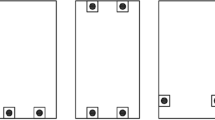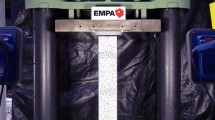Abstract
The use of thermally modified timber for structural purposes is of increasing interest. In order to guarantee sufficient reliability in terms of load bearing capacity and fitness for use the strength and stiffness properties of this modified wood have to be assessed. Industrially produced, thermally modified structural timber members made of beech (Fagus sylvatica L.) were subject of the tests presented in this paper. Bending, tension parallel and perpendicular to grain and compression parallel and perpendicular to grain properties were determined. The derived mechanical properties were benchmarked to the European EN 338 strength class system for structural timber. It turned out that the used strong thermal treatment of the raw material resulted in a significant reduction of most of the strength properties. However, stiffness properties were not affected. In particular the strength properties perpendicular to grain suffered a lot due to the thermal modification whereas compression strength parallel to grain was unchanged. The main drawbacks found along the experiments were a pronounced brittle behaviour of the specimens and big variations in strength. For the determination of strength values it is proposed not to use correlations as provided in European standards but to test and state these properties discretely. On the basis of these results a general use of strongly thermally modified beech as structural timber cannot be recommended. However, for selected purposes, like e.g., for structural façade elements or for columns, the use of this material might be an option.
Zusammenfassung
Die Verwendung von thermisch modifiziertem Holz erfreut sich wachsender Beliebtheit. Für eine Erweiterung der möglichen Anwendungen auf tragende Bauteile müssen deren Festigkeits- und Steifigkeitseigenschaften bekannt sein. Industriell thermisch behandeltes Buchenholz (Fagus sylvatica L.) in Bauteilabmessungen wurde Biege-, Zug- und Druckversuchen parallel und senkrecht zur Faser unterzogen. Die ermittelten Parameter wurden den Festigkeitsklassen nach EN 338 zugeordnet. Es zeigte sich, dass die verwendete intensive thermische Modifikation zu einer signifikanten Reduktion der Festigkeitseigenschaften führte, während die Steifigkeiten mehr oder weniger unverändert blieben. Besonders betroffen von der Reduktion der Werte waren die Festigkeiten senkrecht zur Faser des thermisch behandelten Holzes. Als großes Manko des Materials erwies sich während der Versuche das spröde Bruchverhalten sowie die große Streuung der Festigkeitswerte. Auf der Basis der Resultate kann das verwendete stark thermisch modifizierte Buchenholz nicht für eine generelle Verwendung in tragenden Bauteilen empfohlen werden. Für spezielle Anwendungen, beispielsweise Stützen oder Fassadenelemente, könnte der Einsatz dieses Materials jedoch eine Option sein.







Similar content being viewed by others
References
Bekhta P, Niemz P (2005) Effect of high temperature on the change in color, dimensional stability and mechanical properties of spruce wood. Holzforschung 57(5):539–546
Boonstra MJ, Van Acker J, Tjeerdsma BF, Kegel EV (2007) Strength properties of thermally modified softwoods and its relation to polymeric structural wood constituents. Ann For Sci 64:679–690
Burmester A (1975) Dimensional stabilization of wood. Holz Roh- Werkst 33(9):333–335
Chang CI, Keith CT (1978) Properties of heat-darkened wood: II. Mechanical properties and gluability. Report, Eastern Forest Products Laboratory, Ottawa, Canada
CEN ECfS (2002) EN 13183-1: Moisture content of a piece of sawn timber—part 1: Determination by oven dry method
CEN ECfS (2004) EN 302-3: Adhesives for load-bearing timber structures—test methods—part 3: determination of the effect of acid damage to wood fibres by temperature and humidity cycling on the transverse tensile strength
CEN ECfS (2009) EN 338: Structural timber—strength classes
CEN ECfS (2010a) EN 384: Structural timber—determination of characteristic values of mechanical properties and density
CEN ECfS (2010b) EN 408: Timber structures—structural timber and glued laminated timber—determination of some physical and mechanical properties
CEN ECfS (2010c) EN 1912 + A4: Structural timber—strength classes—assignment of visual grades and species
Finnish-Thermowood-Association (2003) Thermowood handbook. Finnish Thermowood Association, Helsinki
Frese M, Blass HJ (2007) Characteristic bending strength of beech glulam. Mater Struct 40(1):3–13
DIN GIfS (2008) DIN 4074-5 Strength grading of wood—part 5: Sawn hard wood
Hakkou M, Pétrissans M, Gérardin P, Zoulalian A (2006) Investigations of the reasons for fungal durability of heat-treated beech wood. Polym Degrad Stabil 91(2):393–397
Hill CAS (2006) Wood modification: chemical, thermal and other processes renewable resources. Wiley, Southern Gate
Hillis WE (1984) High-temperature and chemical effects on wood stability. 1. General considerations. Wood Sci Technol 18(4):281–293
ISO IOfS (1975) ISO 3131: Wood; determination of density for physical and mechanical tests
Johansson D, Morén T (2006) The potential of colour measurement for strength prediction of thermally treated wood. Holz Roh- Werkst 64(2):104–110
Kamdem DP, Pizzi A, Jermannaud A (2002) Durability of heat-treated wood. Holz Roh- Werkst 60(1):1–6
Kollmann F, Schneider A (1963) On the sorption behaviour of heat stabilized wood. Holz Roh- Werkst 21(3):77–85
Leijten AJM (2004) Heat treated wood and the influence on the impact bending strength. Heron 49(4):349
Majano–Majano A, Hughes M, Fernandez-Cabo JL (2010) The fracture toughness and properties of thermally modified beech and ash at different moisture contents. Wood Sci Technol 46(1):5–21
Millett MA, Gerhards GC (1972) Accelerated aging: residual weight and flexural properties of wood heated in air at 115 °C to 175 °C. Wood Sci 4(4):193–201
Mitteramskogler (2007) Esche, Buche und Eiche mit Hitze veredelt Mehr Wertschöpfung aus heimischen Wäldern
Mitteramskogler (2008) Mirako-thermowood
NIST: National Institute of Standards and Technology (2010) Percentile. In: Engineering statistics handbook
Pollmeier (2009) Pollmeier grading beech. Creuzburg, Germany
Ravenshorst GJP, van de Kuilen JWG (2009) Relationship between local, global and dynamic modulus of elasticity for soft- and hardwoods. In: CIB-W18, meeting 42, paper 42-10-1, Duebendorf, Switzerland
Rusche H (1973a) Thermal-degradation of wood at temperatures up to 200 °C. 1. Strength properties of dried wood after heat-treatment. Holz Roh- Werkst 31(7):273–281
Rusche H (1973b) Thermal degradation of wood at temperatures up to 200 °C. 2. Reaction-kinetics of loss of mass during heat-treatment of wood. Holz Roh- Werkst 31(8):307–312
Schneider A (1971) Investigations on the influence of heat treatments within a range of temperature from 100 °C to 200 °C on the modulus of elaticity, maximum crushing strength and impact work of pine sapwood and beechwood. Holz Roh- Werkst 29(11):431–440
Schöftner R (2007) Holiwood—international research and development for innovative products made out of thermal modified timber. Paper presented at the 3rd European Conference on Wood Modification, Cardiff, UK
Seborg RM, Tarkow H, Stamm AJ (1953) Effect of heat upon the dimensional stabilisation of wood. For Prod J 3(9):59–67
Sell J (1997) Properties and characteristic values of wood species (in German). LIGNUM, Zürich
Wood handbook (1999). Forest Products Laboratory General Technical Report FPL-GTR-113
Yixing L, Jian L, Jinman W, Jinsong Y, Yanhua M (1994) The effect of heat treatment on different species wood colour. J For Res 5(4):73–78
Acknowledgments
The presented work was financially supported by the European Commission under contract No. NMP2-CT-2005-011799 (HOLIWOOD project). The authors would like to thank Mitteramskogler GmbH for the supply of the material and the technical staff of Empa for the support in test preparation and execution.
Author information
Authors and Affiliations
Corresponding author
Rights and permissions
About this article
Cite this article
Widmann, R., Fernandez-Cabo, J.L. & Steiger, R. Mechanical properties of thermally modified beech timber for structural purposes. Eur. J. Wood Prod. 70, 775–784 (2012). https://doi.org/10.1007/s00107-012-0615-x
Received:
Published:
Issue Date:
DOI: https://doi.org/10.1007/s00107-012-0615-x




